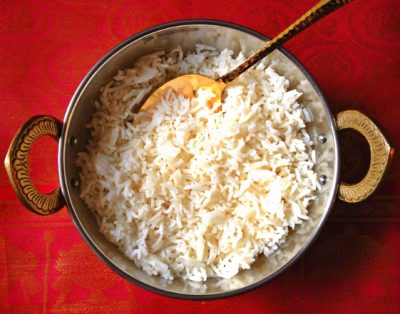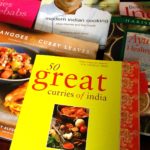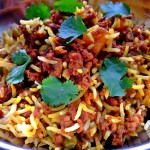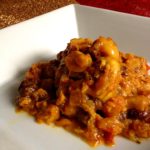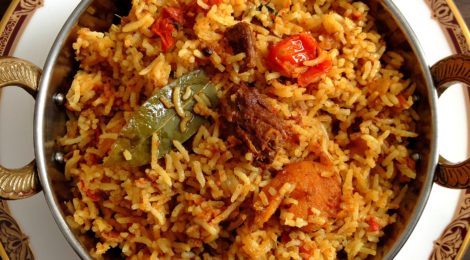
Indian Cooking 401 — Recipe #5: Mastering India’s Ultimate Rice Dish: Biryani

Make India’s ultimate rice dish for your next dinner party: Lamb Biryani (pictured with saffron yogurt sauce)
Indian Cooking 401 – this lesson will focus on how to make the ultimate Indian rice dish perfectly: Biryani
Objectives:
-
Welcome to the big time! Biryani is one of the most challenging Indian dishes to get right. There are countless varieties based on region and country, but there are some key tricks to making biryani well. It’s quite a labor-intensive affair, so even for me, this dish is an elaborate preparation that I only make once a year or on special occasions. In this lesson you will learn how to master it
-
Biryani requires a whole cadre of different spices for every layer of the dish, ranging from black cumin seeds to rosewater. In this recipe you will learn how to utilize them all
-
At the 401 level you are becoming a real pro and will have to visit an Indian grocer or specialty store to buy spices (such as black cumin seeds and nigella seeds) that you won’t be able to find easily at your local supermarket
Biryani is a layered rice-based dish made with basmati rice, spices, and chicken, lamb, or vegetables. Ground and whole spices are key, and depending on the recipe, can range from nutmeg to cloves; saffron reigns supreme in a high quality biryani, and is often soaked in milk or rosewater first. Rice-based dishes exist in many cuisines, from pilafs to paellas to risottos. Even other rice-based Indian dishes like pilau are different from biryani, which distinguishes itself by being a dish where the rice is cooked separately from a thicker meat or vegetable curry after which they are layered rather than mixed and cooked together. This produces an intricate dish of complex and contrasting flavors. In a classic Mughlai lamb biryani preparation, the rice is partially cooked and the lamb curry is marinated, but raw — the dish is then layered together and skillfully cooked over wood until the rice is grainy (not mushy or creamy) and the lamb is cooked just right, tender and falling apart. Today you can eat a variety of biryanis from South Africa to Iran. Each preparation is different, based on local ingredients, spices and herbs. The recipe I show here is a classic Mughlai-style lamb biryani that I’ve updated for the convenience of modern home cooks — more specifically, I fully cook the lamb curry before layering it with the rice, and I soak saffron threads in plain yogurt for an hour, which rather than add to the layered biryani, I serve it on the side as a finishing sauce to drizzle over the biryani (as pictured in the photo above).

By the 15th century, the wealthy Persian empire stretched thousands of miles, from eastern Syria to points near China. The Mughal Empire ruled most of India in the 1600s and 1700s. Leading lives of great refinement (literature, poetry, languages, history and painting) the Persian empire was considered among the most civilized in the world. (Source: PBS)
For centuries the Indian subcontinent was ruled by different foreign powers from the Persians to the British Empire. The Mughal Empire controlled most of India from the 1500s-1700s, whose emperors were Muslims and direct descendants of both Genghis Khan and Tamerlane. Mughlai cuisine was born during this time, which is a hybrid style of cooking developed in India by the imperial kitchens of the Mughal Empire (the cooking styles used in North India (especially Uttar Pradesh and Delhi), Pakistan, Bangladesh and the South Indian city of Hyderabad). The cuisine is strongly influenced by the Persian cuisine of Iran and influenced the regional cuisines of Kashmir and Punjab. Today, for many people outside India, Mughlai dishes are considered “Indian food.” According to the wonderful book Curry: A Tale of Cooks and Conquerors early Mughal emperors for whom food and the art of cuisine were highly important, were not impressed by the native Indian cuisine they discovered — the only exception was Indian rice, which was expensive and luxurious. Humuyan, the second Mughal emperor brought accomplished Persian cooks with him to India, and the piece de resistance of Persian cuisine was pilau. A good pilau was judged by the quality of the fluffy, fragrant rice that was “highly aromatic, filling the room with the delicate scent of its spices”. There were many variations of pilaus, such as fruit pilaus, turmeric and saffron pilaus, chicken pilaus, and so on.
ORIGINS OF BIRYANI: From Persia pilau spread throughout the Muslim world. In Turkey it was called pilav. In Spain, with the addition of seafood and an emhasis on saffron it became paella. In Italy, butter transformed it into risotto.” In India, where Persian and Central Asian culture fused with that of Hindustan, pilau was to undergo yet another transformation in the kitchens of the third Mughal emperor Akbar (1555-1605)
Akbar, the third Mughal emperor, felt the most at home in India and took steps to meld the cultural links of India, Central Asia, and Persia in art, which translated to the cuisine as well — the delicately flavored Perisan pilau met the pungent and spicy rice dishes of India to create the classic Mughlai dish: Biryani.
Lamb Biryani
Serves 6
I. Lamb
Ingredients
- 1 teaspoon coriander powder
- 1 teaspoon kashmiri chilli powder
- 1 teaspoon paprika
- 1 teaspoon cumin
- 5 medium onions (4 finely chopped and 1 sliced thinly into rings)
- 1/2 teaspoon black peppercorns
- 2 bay leaves
- 4 whole cloves
- 4 green cardamom pods
- 1 teaspoon black cumin
- 1 cup canola oil
- 12 fresh garlic cloves
- 1/8 teaspoon saffron
- 1 packet Shan brand Biryani Masala
- 1.5 pints grape tomatoes (1.5 boxes)
- 1-inch fresh ginger root, peeled and grated
- 1 cup plain yogurt
- 10 dried apricots
- 2 lbs boneless, skinless lamb, cubed
Preparation
- In a small bowl, combine the coriander powder, kashmiri chilli powder, paprika, and cumin powder
- Finely chop 4 medium onions. Slice another medium onion into rings for roasting (for garnish before serving).
- Place a dutch oven or large skillet on the stove but don’t turn the heat on yet. Add black peppercorns, bay leaves, cloves, green cardamom, black cumin, and chopped onions. Add canola oil and heat on medium-high flame.
- Once the oil mixture is bubbling, add the garlic cloves, followed by saffron. Then add the ground spices in the small bowl, and biryani masala packet. Mix well to combine.
- Grate fresh ginger. Once the onions are golden brown, add grape tomatoes, grated ginger, and plain yogurt. Mix well. Let it continue cooking the tomatoes have wilted and the yogurt is well combined. Stir occasionally, breaking up softened garlic cloves with the back of a wooden spoon.
- Add lamb and combine well. Fold in dried apricots. Continue cooking on medium-low heat for 1.5 hours or until the lamb is tender and falling apart (see photo below). While the lamb is cooking down, prepare the i) roasted onions and ii) yogurt saffron sauce (see both recipes below).

Starting from top left: boneless, skinless lamb; onions, garlic cloves, ginger root, grape tomatoes; yogurt, canola oil, dried apricots

Starting from top left: coriander powder, kashmiri red chilli powder, paprika, cumin powder, black peppercorns, bay leaves, whole cloves, green cardamom, Shan brand Biryani Masala spice mix, cinnamon stick, cumin seeds, saffron, black cumin, uncooked basmati rice
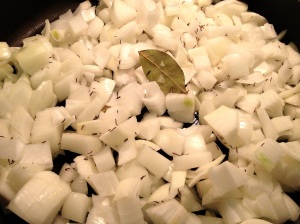
Before turning on the heat, add onions and whole spices to your skillet

Add oil and heat on medium-high flame

Add grape tomatoes, yogurt, and ground spices

Add lamb and dried apricots

Continue cooking down lamb until the consistency looks like this
II. Biryani Rice
Ingredients
- 6 cups water
- 2 green cardamom pods
- 2 whole cloves
- 1/2 teaspoon black cumin seeds
- 2 bay leaves
- 1/2 teaspoon white cumin seeds
- 2-3 pieces cinnamon stick
- 1 teaspoon kosher salt
- 3 cups uncooked white basmati rice
Preparation
- Fill a large saucepan with 6 cups of water. Add cardamom, cloves, black cumin seeds, bay leaves, white cumin seeds, cinnamon stick, salt.
- Bring water to a boil.
- Add basmati rice and bring to a boil.
- Cook on low until just cooked (16-18 minutes).

Prepare biryani rice by steaming uncooked white basmati rice with water and whole spices like cumin and bay leaf — until it’s “just” fully cooked

I cooked mine a little to close to “fully cooked’ so immediately removed it from the pot and divided it into bowls to cool it down — a big tip if you’re ever in the same spot
III. Roasted Onions
Ingredients
- 2 medium onions, finely sliced into thin rings
- 1/4 cup canola oil
Preparation
- Heat oil in a large, non-stick skillet on medium-high. Add all the sliced onions, stirring for 5 minutes. Continue to saute, turning the heat down a little, until the onions are reddish-brown. Remove the onions with a slotted spoon and spread them out on a large platter lined with paper towel.
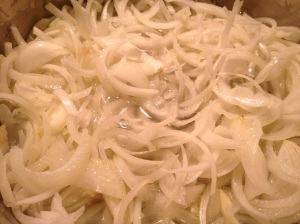
When the oil is hot, add all the sliced onions and begin sautéing
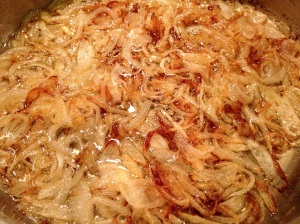
As you saute the onions they will start to turn reddish-brown
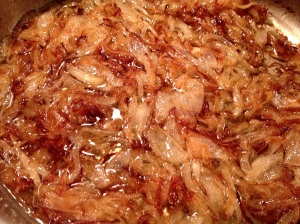
Until they look like this, whereupon…

…remove them with a slotted spoon and spread them out on a large platter lined with paper towel
IV. Saffron yogurt sauce
Ingredients
- 1/2 cup plain whole milk yogurt
- 1 teaspoon saffron
Preparation
- Sprinkle 1 teaspoon saffron threads into yogurt in a small bowl. Don’t stir, just let it combine on its own.
- After 30-60 minutes, gently mix with a fork or small whisk.
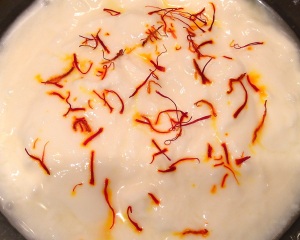
Create a luxurious saffron yogurt sauce by combining whole fat yogurt with a few strands of saffron in a small bowl for 30-60 minutes before required.
V. Layering the Biryani
Ingredients
- Lamb mixture
- Biryani Rice
- Roasted onions
Preparation
- Preheat oven to 350F.
- While oven is preheating, begin layering process in large roasting pan or tall saucepan: Layer #1: a) 1/2 rice Layer #2: 1/2 lamb. Repeat layers and finish with a layer of rice.
- Top with roasted onions.
- Bake in oven for 10 minutes so that everything is cooked through and begins melding together.
- Remove from oven after 10 minutes. Do not mix the biryani, but rather, fold it gently a couple of times before transferring to a large serving platter.
- Enjoy the lamb biryani with a side of saffron yogurt sauce.
TIP: If you plan on serving it the next day, cover the biryani tightly with a matching lid or aluminum foil, and refrigerate. One hour before you want to serve it, preheat oven to 350F and bake for 60 min. Then follow step #5 above.

Begin layering the biryani in a large, deep dish starting with the rice

Add half the cooked lamb mixture

Continue alternating layers of rice and lamb; finish with a top layer of rice and spread out the roasted onions on top

This is how it should look when you’re done

If you plan on serving the biryani the next day, cover it tightly with a matching lid or aluminum foil and refrigerate.
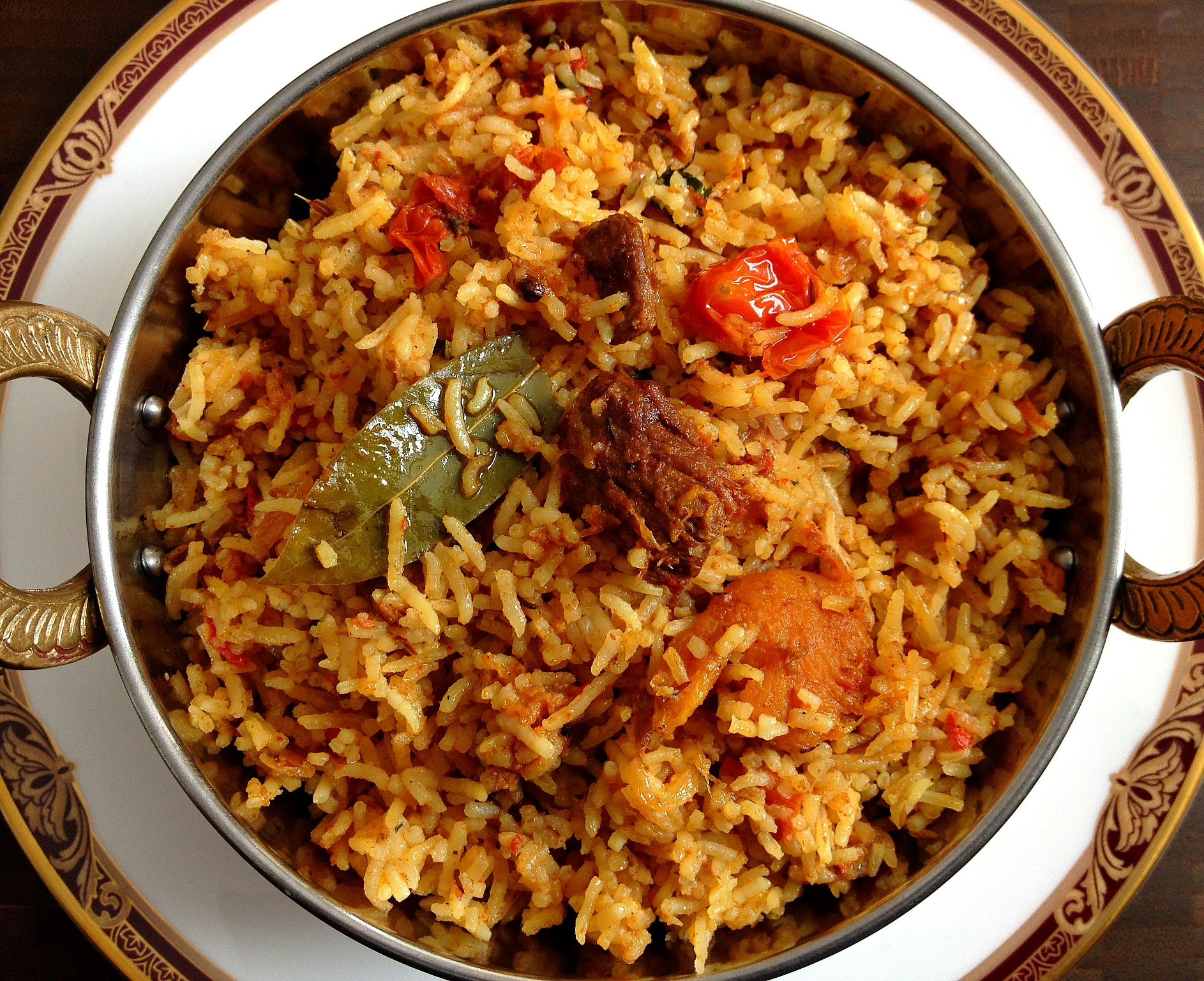
Lamb Biryani studded with succulently slow-cooked lamb, dried apricots, tomatoes, and lots of other good things. A feast fit for your king or queen!
